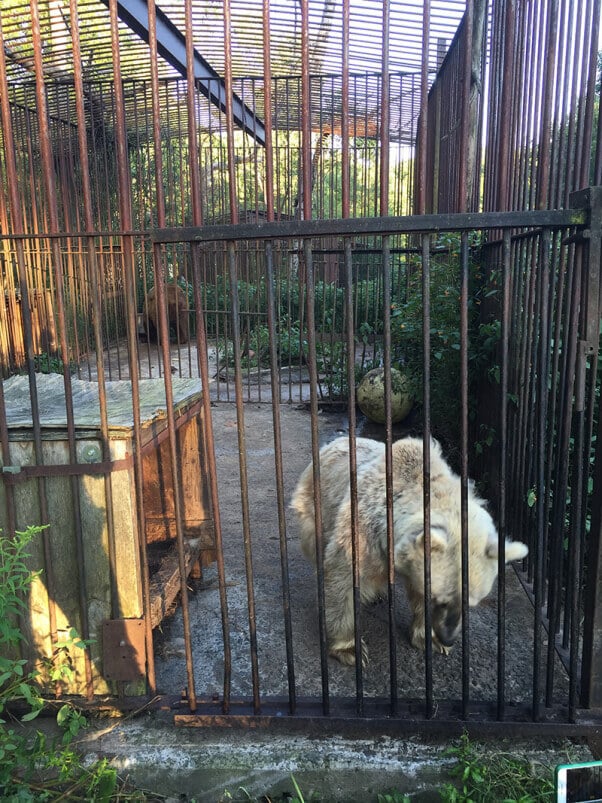How to Tell if a Place Is a REAL Animal Sanctuary
For people who care about animals and want to support rescue efforts, sanctuaries can be an appealing and compassionate alternative to exploitative captive facilities. However, many cruel roadside zoos and breeding facilities are now marketing their animal prisons as “sanctuaries” or “rescues” and claiming to support species conservation in order to attract customers. Don’t fall victim to these deceptive ploys. Asking a few simple questions can usually help you determine whether a facility is helping or exploiting animals.
You can easily find answers to these questions by browsing the facility’s website and social media pages before visiting:
1. How are animals housed?
Reputable sanctuaries make every effort to replicate an animal’s natural habitat. Animals who are members of social species should share their space with suitable partners who can provide companionship and emotional stimulation. Cramped pens with concrete floors or enclosures with pacing paths worn along the perimeter are red flags.

2. What kinds of environmental enrichment are offered?
Habitats should offer multiple outlets for physical and psychological stimulation, such as expansive structures for chimpanzees to climb, ponds or pools for bears to bathe and splash in, and large fields for grazing animals to enjoy. The aim of enrichment is to provide outlets for animals to engage in natural behaviors—not to create an appealing scene for visitors.

The social needs of the animals must also be a top priority. Members of social species should be placed with compatible companions of the same species, as doing so allows them to use their natural social abilities to form relationships, herds, and packs. In many true sanctuaries, the animal residents act as fellow “rehabilitators” who teach newcomers who have been abused how to get back in touch with their instincts and embrace their new environment.
3. How big is the facility?
Depending on the specific needs of their species, animals should be provided ample horizontal and vertical space to explore, roam, climb, and forage, among other types of natural behavior. And sanctuaries never take their inhabitants out on the road for public display—instead, animals spend their days in a comfortable and stimulating environment with minimal human interference.
4. Are visitors allowed to touch or hold animals?
No reputable sanctuary that houses wild or exotic animals (big cats, bears, primates, wolves) allows any kind of hands-on interaction, and that includes posing for photos with animals. Such interactions are disruptive and frightening for them—and endanger both them and the visitors. Animals are not props.
However, many sanctuaries that care for domesticated and rescued farmed animals do allow visitors to get up close and personal with willing residents—and that’s a wonderful thing.
5. How are animals acquired?
Countless animals are discarded by private owners who can’t provide adequate care as well as circuses, roadside zoos, laboratories, and other exploitive industries. True sanctuaries provide animals with a permanent home until the day they die, except in very rare instances when it is in the best interest of the animal. They don’t trade, borrow, or loan animals. Animals who call a true sanctuary their home likely had a rough start, and staff will be eager to tell you their individual stories so that you can learn more about the various industries that are harmful to animals.
6. Does the facility breed animals?
Reputable sanctuaries do not breed animals because they know that doing so contributes to the problem that they are trying to solve, takes up valuable sanctuary space that could be occupied by a rescued animal, and depletes their already limited resources to rescue others in need.
7. Are they accredited?
Check whether a sanctuary is accredited by the Global Federation of Animal Sanctuaries (GFAS) before deciding to visit. GFAS is an accrediting organization that requires member sanctuaries to observe a strict code of ethics and meet animal-welfare standards that far exceed the minimal ones outlined in the federal Animal Welfare Act. Sanctuaries accredited by GFAS never breed or sell animals, and they allow rescued exotic animals to live out the rest of their lives in peaceful, spacious, natural habitats with members of their own species.
And one final tip: Trust your gut.
If you’re concerned that a particular facility might be mistreating animals for the sake of profit, ask more questions. If you’re already there, express your concerns, ask for a refund, and leave. Report what you saw to PETA, and let your friends and family know never to visit.
Roadside zoos and backyard menageries are often small-scale operations where animals are kept in ramshackle concrete or dirt-floored cages. Most of these facilities don’t even have a blade of grass, much less any meaningful enrichment. PETA has helped rescue many animals who were deprived of proper care at such facilities and are now living out their days in reputable sanctuaries.
Above all, it’s important to recognize that all living beings deserve a peaceful space without interference from gawking tourists. A true sanctuary places the needs and desires of its inhabitants over those of paying visitors and provides a lifetime of excellent care.

Never visit a roadside zoo or pseudo-sanctuary. Ticket sales fund neglect and cruelty, and no visit is worth the lifetime of suffering that animals endure when they’re stripped of their dignity and everything that’s natural and important to them. Use this opportunity to explain to your friends and family why animals don’t belong in roadside zoos and why you don’t support cruelty.
Take Action
Tigers are the most commonly exploited animals at facilities claiming to be “rescues.”




